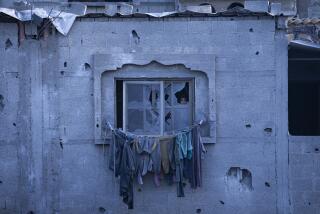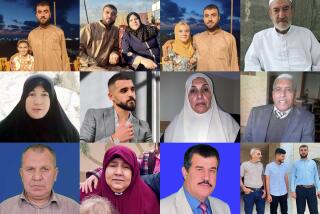Speed, Force Marked Lethal Raid
- Share via
MOSUL, Iraq — Sheik Nawaf Zaidan had been looking a bit edgy lately, his neighbors say.
A well-connected building contractor in his 50s, he had complained to merchants in his affluent area of Mosul that he had been unable to sleep much, only about one or two hours a night. When the electricity went out a few weeks ago, he ran over in a panic and begged for an immediate line from a generator.
On Tuesday morning, the probable reason for Zaidan’s anxiety was revealed.
“I’ve got Uday, Qusai and big, big problems,” he is said to have told a neighbor, to whose home Zaidan had been spirited by U.S. troops.
It was an understatement. By that time, U.S. forces were already shooting .50-caliber machine-gun rounds through his front door nearby.
After almost four hours of heavy fire, Uday and Qusai Hussein -- the two most feared men in Iraq after their father, Saddam -- were dead along with a bodyguard, U.S. officials said.
Only one combatant inside the house remained alive: Qusai’s 14-year-old son, Mustafa. The teenager fired a final burst of AK-47 fire at the troops until he too was overwhelmed and killed, officials said.
The assault on Zaidan’s imposing three-story home along a busy thoroughfare out of this northern Iraq city has been hailed as a turning point in the U.S. effort to win the peace in postwar Iraq. During four hours of shooting -- U.S. officials initially had said the battle lasted six hours -- the three men and one boy inside the home held back a force of about 200 soldiers aided by heavy weaponry and assault helicopters.
A day after the battle, journalists were still trying to piece together an accurate account of the frenetic events at the Zaidan residence. Some questions remain, such as the identity of the tipster who alerted U.S. intelligence on where the Hussein brothers could be found and why American forces opted to use deadly force rather than wait out the fugitives and attempt to capture them alive.
There also may be questions about whether Uday died of a self-inflicted gunshot wound. ABC News reported that a U.S. official said there is an exit wound on top of Uday’s head.
But based on statements by the U.S. military commander in Iraq, Lt. Gen. Ricardo Sanchez, and comments of neighbors and witnesses, a recounting of the day’s events can be made. The circumstantial evidence raises suspicions that Zaidan fingered his houseguests, despite the fact that Zaidan and the Husseins belonged to the same tribe and Zaidan had received business concessions or favors from the regime.
In any case, it was a combination of a speedy reaction to information and overwhelming force that put an end to the two brothers, who -- true to their family’s Mafia-like credo -- chose to die together with guns in their hands rather than surrender.
After an unidentified Iraqi told U.S. forces on Monday night that Uday and Qusai were inside house No. 6 in the prosperous Falah district, U.S. military commanders scrambled late into the night to craft a battle plan that would begin at 10 a.m.
Fueling the rumor that Zaidan was the tipster, he had made sure ahead of the battle that his wife and daughters were away. Unusual for him, said members of the Ziad Mohammed Katib family, who live two doors up the street, Zaidan had gone out around 6 a.m. Even more strangely, he took his wife, son and young daughters with him.
According to Ziad Katib’s 15-year-old son, Yehia, by the time Zaidan and his son returned -- alone, without the female family members -- American forces had already arrived outside Zaidan’s house prepared to search it, by force if necessary.
Zaidan and his son, Shalan, returned around 9 a.m., according to another neighbor, Shalan Rashid Khazraji. The Katib and Khazraji families agree that Zaidan and his son were quickly taken into custody by the Americans, but the families give slightly different versions.
According to the Katibs, American troops grabbed the two when they came to a gate.
Khazraji said that at 9:30 a.m., Zaidan dashed out one gate while his son ran out another, and they were swiftly swept up by U.S. soldiers.
Neighbors also said that for detainees, Zaidan and his son appeared to have been given kid-glove treatment. The pair were first allowed to sit in an American vehicle and then they were taken into an elaborate, three-story house nearby. While talking to a son of the owner of that house, Zaidan made his remark about having Uday and Qusai in his home, posing “big, big problems,” according to Khazraji, who said the comment quickly reverberated around the neighborhood.
It was the first time neighbors realized who the American troops were after, and it came as a complete shock to Katib, who said he had no inkling that Uday and Qusai were there.
“We did not notice anything,” Katib said. Zaidan “always had many guests.”
Khazraji said Zaidan was also heard urging the Americans not to enter his house, because they would face fierce resistance.
The accounts of Sanchez and the neighbors were consistent regarding the active part of the siege beginning at 10 a.m. with a bullhorn call ordering those inside to come out. With no answer, Sanchez said later, negotiations were essentially over.
Ten minutes later, troops knocked on the door. Again, there was no response, so the soldiers burst in and immediately faced small-arms fire, apparently from AK-47s wielded by Uday, Qusai, Mustafa and the bodyguard from the barricaded second floor, Sanchez said.
The first volley of gunfire wounded three Americans on the stairs to the second floor and a fourth outside the building. The Americans, soldiers from the 101st Airborne Division and special operations troops pulled out to evacuate their casualties via helicopter and ask for backup -- a quick reaction force and heavier weapons. Inside, the gunmen were lobbing grenades at Special Forces soldiers on the roof.
After the troops withdrew from the house, soldiers riddled it with Mark 19 grenades, AT4 antitank rockets and Humvee-mounted .50-caliber machine guns, Sanchez said.
The “prep” fire still wasn’t done. Reinforcements from the 101st’s 2nd Brigade arrived at 11:22 a.m.
Then, at 11:45, came Kiowa OH58D helicopters, firing 10 2.75-inch rockets. Two struck behind the house, two fell in a vacant lot next door and the rest were direct hits, neighbors said.
Some Iraqis expressed dismay at the firepower.
“If Uday and Qusai were inside that house, 10 soldiers would have been enough. They didn’t have to surround the whole building,” said a patron at a grocery store across the street, who declined to give his name.
At noon, according to Sanchez’s timeline, the soldiers burst through the doorway a second time. They cleared the first floor but withdrew, wary of the barricade at the top of the stairs. The four inside were all believed to have survived a three-hour onslaught, Sanchez said.
Commanders huddled on the radio, considering destroying the house with Apache helicopters and A-10 Warthog warplanes hovering nearby, but they feared heavy casualties among the neighbors. Instead, at 1 p.m., they ordered heavy fire with the machine guns, Mark 19s and, for the first time, TOW missiles fired from Humvees.
Uday, Qusai and the bodyguard were dead, Sanchez said. “We believe it was the TOW missile attack that wound up killing three of the adults,” he said.
That left young Mustafa.
At 1:21 p.m., the soldiers walked through the door for the third time. Moving cautiously up the stairs, they took no fire -- until they reached the top. Mustafa then fired his AK-47, Sanchez said. It was his final act.
Several witnesses said four bodies were taken out of the building -- a bearded man and three others under blankets. To some, it seemed far too much firepower for three men and a teenager.
“Why did the Americans kill Uday and Qusai? We wanted them alive so they could be questioned,” said Masin Ibrahim, a resident who watched the scene unfold. “They really wanted to kill them, without giving them a chance to surrender.”
Knowing that the legend of Uday and Qusai would live on -- along with the inspiration to kill American soldiers on their behalf until their deaths were proven -- U.S. troops ferried the bodies to the Baghdad airport for a series of identification tests. First, they brought in four unidentified “senior former regime members” who are familiar with the infamous Hussein brothers.
Then they compared old medical X-rays to verify that Uday’s body bore the scars of a previous assassination attempt, Sanchez said. It did, he said.
Then they matched dental records. The results, Sanchez said: 90% match for Uday, 100% for Qusai.
“Autopsies will follow, but we have no doubt we have the bodies of Uday and Qusai,” Sanchez told reporters. U.S. Defense Secretary Donald H. Rumsfeld said that photos of the bodies also would be released.
On Wednesday, a crowd of nearly 200 gathered across the street from the site of the shooting. The tension between them and the soldiers of the 101st Airborne was palpable. At one point, a group of about 20 young men began an old Hussein-era chant: “With our blood and souls, we will sacrifice ourselves for you, Saddam!” Several held up pieces of Iraqi currency -- which still bears the fugitive dictator’s image.
“People of Mosul, please leave the area or we will arrest you. We killed Uday and Qusai yesterday. Now we are going to clear the area. Anyone who remains will be considered as a supporter of Uday and Qusai,” an Arabic-speaking interpreter for the Americans said through a bullhorn.
After a two-minute warning, the soldiers went in, arresting and then releasing a straggler -- who gave his name as Mohammed Refai -- who did not run away fast enough.
A few blocks down, a soldier armed with an M-16 ordered another Iraqi, Juma Ahmed Ridha, to stop his van, then shot out his back window and dragged the driver out. As blood streamed from his head down his white tunic, Ridha pleaded to a reporter in Arabic: “I have no idea why they beat me. I just came here to have a look.”
What kept curious onlookers milling outside Zaidan’s home, they said, was a number of unanswered questions: What happened to the nearly $1 billion Qusai took from Iraq’s central bank before disappearing? Is Saddam Hussein directing the guerrilla resistance? Is the coalition any closer to locating him?
“I’m not sure I can give you” an exact answer, Sanchez said at a briefing for reporters in Baghdad. “But I will tell you our focus is unequivocal. We know what our targets are.... The Saddam Hussein regime will never come back into power.”
Zaidan and his son apparently remained with American troops late Wednesday for their own protection, and his wife and daughters have not reappeared. A spokesman at the opulent Mosul house of Zaidan’s brother, Salah, said he had no idea where the wife and daughter had gone.
But if Zaidan was indeed the tipster, the family stands to be richer by $30 million -- the reward on the heads of Uday and Qusai -- and Zaidan’s “big, big problems” may be over.
*
Daniszewski and Hendren reported from Mosul and Zucchino from Baghdad.
More to Read
Sign up for Essential California
The most important California stories and recommendations in your inbox every morning.
You may occasionally receive promotional content from the Los Angeles Times.











